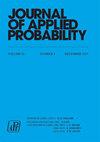近乎退化的变化环境中的分支过程
IF 0.7
4区 数学
Q3 STATISTICS & PROBABILITY
引用次数: 0
摘要
我们研究了变化环境中的分支过程,对于这种过程,$\overline{f}_n \to 1$,$\sum_{n=1}^\infty (1-\overline{f}_n)_+ = \infty$,$\sum_{n=1}^\infty (\overline{f}_n - 1)_+ < \infty$,其中$\overline{f}_n$代表第 n 代的后代平均值。由于亚临界状态占主导地位,这种过程几乎肯定会消亡,因此,为了得到一个非微观极限,我们考虑了两种情况:以不消亡为条件,以及增加移民。在这两种情况下,我们都证明了该过程在分布上无需归一化即可收敛到非退化的复合泊松极限规律。证明依赖于 Kersting(2020 年)提出的形状函数技术。本文章由计算机程序翻译,如有差异,请以英文原文为准。
Branching processes in nearly degenerate varying environment
We investigate branching processes in varying environment, for which $\overline{f}_n \to 1$ and $\sum_{n=1}^\infty (1-\overline{f}_n)_+ = \infty$ , $\sum_{n=1}^\infty (\overline{f}_n - 1)_+ < \infty$ , where $\overline{f}_n$ stands for the offspring mean in generation n . Since subcritical regimes dominate, such processes die out almost surely, therefore to obtain a nontrivial limit we consider two scenarios: conditioning on nonextinction, and adding immigration. In both cases we show that the process converges in distribution without normalization to a nondegenerate compound-Poisson limit law. The proofs rely on the shape function technique, worked out by Kersting (2020).
求助全文
通过发布文献求助,成功后即可免费获取论文全文。
去求助
来源期刊

Journal of Applied Probability
数学-统计学与概率论
CiteScore
1.50
自引率
10.00%
发文量
92
审稿时长
6-12 weeks
期刊介绍:
Journal of Applied Probability is the oldest journal devoted to the publication of research in the field of applied probability. It is an international journal published by the Applied Probability Trust, and it serves as a companion publication to the Advances in Applied Probability. Its wide audience includes leading researchers across the entire spectrum of applied probability, including biosciences applications, operations research, telecommunications, computer science, engineering, epidemiology, financial mathematics, the physical and social sciences, and any field where stochastic modeling is used.
A submission to Applied Probability represents a submission that may, at the Editor-in-Chief’s discretion, appear in either the Journal of Applied Probability or the Advances in Applied Probability. Typically, shorter papers appear in the Journal, with longer contributions appearing in the Advances.
 求助内容:
求助内容: 应助结果提醒方式:
应助结果提醒方式:


